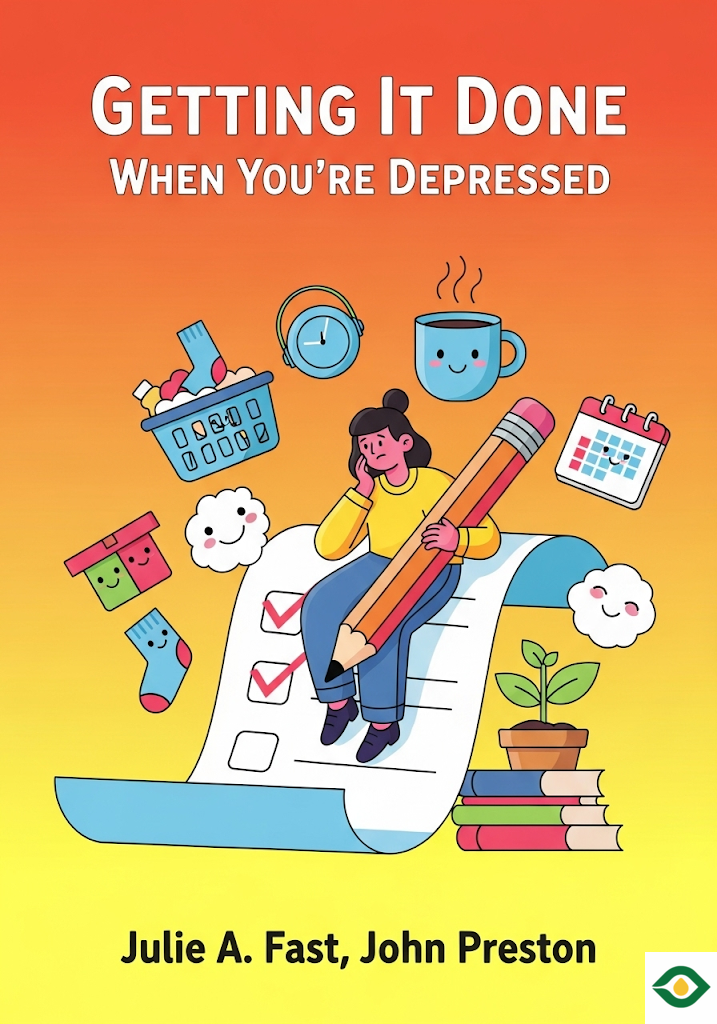Description
Depression often feels like a heavy shadow that lingers over every part of life. It takes away energy, clouds thoughts, and makes even the simplest tasks look impossible. When you are stuck in that state, it’s easy to believe you must wait until you feel motivated before doing anything. But waiting rarely helps. The truth is, taking action often comes first, and motivation follows later. Even the smallest step can break the cycle of stillness and help you feel a little more in control.
One of the most important lessons is that feelings do not always match reality. You might think your work will be poor if you feel low, but that is not necessarily true. Many people discover that once they begin, the quality of what they do is just as good as on their better days. Action is what moves life forward, not waiting for the “perfect” mood.
Social media can make this struggle harder. Scrolling endlessly feels like doing something, but it drains energy and increases feelings of inadequacy. All those polished pictures and success stories can deepen the belief that your own efforts don’t matter. A useful approach is to treat social media as a reward rather than a default activity. Finish a task first, and then allow yourself a short scroll. This small shift helps restore balance.
Depression also pushes attention inward, making people focus mainly on their own pain. This self-focus is not selfish—it is a symptom. But it can make relationships strained. A helpful strategy is to shift even a little focus outward, perhaps by asking someone how their day is going, offering encouragement, or simply noticing others. This small act of turning attention outward can ease isolation and build connection.
Harsh self-criticism is another common burden. Depression convinces you that your efforts are worthless before you even finish. The best way to fight this is to suspend judgment until after the task is complete. Many times, the end result surprises you and proves the inner critic wrong.
Some people find strength in giving themselves firm instructions, almost like an internal coach. On especially hard mornings, telling yourself “Get up, get dressed, move!” can push you through the wall of inertia. This commanding voice doesn’t have to be harsh; it can be strong but caring, like the voice of your healthiest self pulling you forward.
Structure is also powerful. Depression thrives on chaos and unstructured time. Adding routine, even a simple one, provides stability. Something as small as planning one activity for the day, or setting a clear start and stop time for work, can anchor you. For some, even small routines—like making coffee at the same time, going for a walk, or tidying a room—create a rhythm that quiets the confusion depression brings.
Thinking like an athlete offers another strategy. Athletes succeed not just through inspiration but through discipline and steady training. In the same way, treating exercise as essential maintenance for the mind and body, not as an optional extra, makes it easier to stick with. Even a short walk can lift mood, clear thinking, and build momentum.
It’s equally important to remember that depression twists reality. When it tells you that you are useless or incapable, that is the illness speaking, not the truth. By naming those thoughts as symptoms rather than facts, you give yourself space to respond with compassion instead of blame. Saying, “This is depression, not me,” can help you separate the illness from your identity.
Another essential piece of progress is connection. Having a supportive friend nearby can make all the difference. Sometimes it is not even about active help—just working side by side with someone else can pull you through. Choosing a disciplined or encouraging partner makes it easier to stay on track. Isolation, on the other hand, feeds depression. Reaching out, even in small ways, helps break that cycle.
It can also help to educate loved ones about what you are going through. Many people want to support you but don’t know how. By explaining what helps—for example, reminding you about bills, or sitting with you while you complete a task—you allow them to offer the right kind of support.
Environment plays a huge role in mood and focus. A cluttered, noisy, or dim space can increase the weight of depression, while a calm, light-filled space can make it easier to work. Creating a workspace that suits you—even if it’s just a small corner with a plant or a clean desk—can change how you feel about the day. If possible, natural light, fresh air, or a comforting object can bring ease.
Movement is another proven helper. Exercise may feel impossible at first, but it does not need to be extreme. Walking, stretching, or doing simple exercises at home can trigger endorphins and lift energy. The key is consistency, not intensity. Small daily actions add up to large improvements.
Creative expression is another form of medicine. Depression can steal joy, but creativity brings it back. Picking up a pencil, writing a page, cooking something new, or engaging in a hobby—even when you don’t feel like it—can spark moments of relief. Often, the hardest part is starting, but once you begin, the process becomes nourishing.
Depression also distorts self-talk. Negative words, whether said to yourself or others, deepen the sense of isolation. Choosing to pause before speaking, or replacing harsh comments with simple gratitude, can preserve relationships and soften the heaviness. What you say, even in small interactions, can either fuel depression or help quiet it.
Lifestyle choices can make symptoms heavier or lighter. Caffeine, sugar, and alcohol often provide quick comfort but lead to bigger crashes. Replacing them with balanced snacks, water, or gentler options stabilizes energy and prevents mood swings. These small choices, repeated often, create a stronger foundation for healing.
Progress with depression rarely happens in a straight line. Some days feel like setbacks, and that can be discouraging. But the key is to focus on patience and persistence. Small victories matter. Celebrate them, even if they feel tiny. Saying, “I’m proud I did that,” builds a habit of kindness toward yourself. Over time, this replaces harsh self-criticism with supportive inner talk.
Long-term success comes from seeing progress as a slow but steady climb. Thinking in years rather than days makes setbacks feel smaller. Time will pass either way; using it to build small habits ensures that the future is brighter.
The heart of this approach is balance—balance between persistence and self-compassion. Depression can make each step feel small and unimportant, but each one moves you closer to feeling better. The illness does not define you. By acting even when you don’t feel like it, connecting with others, creating structure, and celebrating small wins, you slowly reclaim your life.
In the end, the most powerful truth is this: you do not need to wait to feel ready. Start small, act gently but firmly, and let each step carry you forward. Over time, these actions build strength, ease the weight of depression, and help you rediscover what makes life meaningful.





